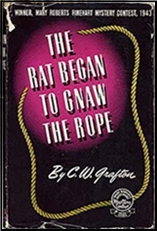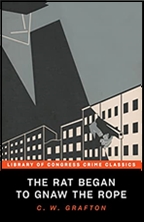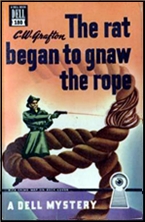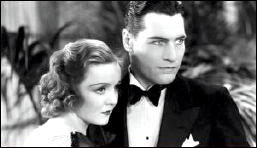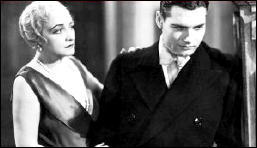Detective Fiction Read in 2010:
An Annotated List by J. F. NORRIS.
Here’s my contribution to the lists that are popping up now that 2010 is over. I read nearly 100 books last year but not even half of them were vintage detective novels. I’ll have to rectify that this year.
The list is in chronological order and not ranked because I can’t ever put my likes in numerical order or even apply letter grades. I did, however, add some highly opinionated comments after most of the titles to give you an idea of how much I liked or disliked a book.
Titles in BOLD were excellent and entertaining on all levels. All of those titles are well worth seeking out. Good luck with finding them though, as nearly all are out of print and scarce in the used book trade. The stinker books (and there were quite a few) are at the bottom of the list after the row of asterisks.
â— The Red Lady – Anthony Wynne. (Impossible crime with a clever gimmick that fooled me. How could I not see that one coming?)
â— The Chinese Orange Mystery – Ellery Queen. (A re-read for me.)
â— The Curse of the Bronze Lamp – Carter Dickson.
â— The House Without a Key – Earl Derr Biggers. (First ever time I read a Charlie Chan book. Rather surprisingly good.)
â— The Emperor’s Snuff Box – John Dickson Carr. (Brilliant! Why has it never been filmed? Would work beautifully on screen. Very Rear Window like, plus many cinematic sequences.) [FOOTNOTE.]
â— The Horseman of Death – Anthony Wynne. (One of his dull ones. Went on and on and on. Ugh.)
â— About the Murder of a Man Afraid of Women – Anthony Abbot. (One of the better Thatcher Colt books, heavy on action in the last third. You learn a lot about ballistics in his one. Truly a surprising ending. I gasped, believe it or not.)
â— The Ghost Hunters – Gordon Meyrick. (Short stories about an occult detective, all supernatural elements with the exception of one story are rationalized. Mediocre. One story was like a “Scooby Doo” cartoon in print.).
â— The Greek Coffin Mystery – Ellery Queen. (Another re-read. Ellery’s lectures and overall pedanticism are annoying to me now. I think I loved them when I read them as a teenager.)
â— The Witness at the Window – Charles Barry. (Silly, but entertaining in a Gun in Cheek kind of way. Has a secondary, French-speaking detective who appears in the last half of the book who is obviously a Poirot parody.)
â— Poison Unknown – Charles Dutton. (More of an action thriller. From Dutton’s later period when he abandoned his scientific detective John Bartley in favor of the youthful Harley Manners who tended to resort to traps and gimmicks when unmasking the killer.)
â— The Cleverness of Mr. Budd – Gerald Verner.
â— All Fall Down – L.A. G. Strong. (Trenchant wit, good plot, forgotten writer whether as a mainstream novelist, short story writer or detective story writer. Well worth tracking down all of his detective novels. Also his supernatural short stories.)
â— Murder of a Chemist – Miles Burton. (Extremely rare book. I read it then sold it online for an outrageous sum. Email me for details if you’re curious about the sale. The book is not really worth reading though.)
â— Tragedy on the Line – John Rhode. (The early Rhode’s are surprisingly good, IMO. Rhode gets a bad rap as one of the dreary writers, but he often is entertaining. Sometimes ingenious.)
â— The Claverton Mystery – John Rhode. (Surely one of his best, near brilliant.).
â— Into the Void – Florence Converse. (Odd little book about bootlegging in a New England village, has a quasi impossible crime plot, more interesting as a study in the American village as microcosm than as a detective story.)
â— Death on Tiptoe – R.C. Ashby. (I loved this! But I have a penchant for Gothic elements in the detective novel. My review for this book can be found here.)
â— Out of the Darkness – Charles Dutton. (Author’s first book, underrated writer. He wrote a handful of books that deal with the psychopathology of multiple murderers long before anyone was writing about demented serial killers. This one deals remarkably well with the after effects of shell shock.)
â— The Crooked Cross – Charles Dutton. (Once again emphasis on the psychopathology of murder. Fundamentalist Christian beliefs lead to mania.)
â— The Lava Flow Murders – Max Long. (See my review here for more on this book.)
â— Cue for Murder – Helen McCloy. (Near brilliant. Title serves as a huge clue. Basil Willing and McCloy never really get their due when discussing the cream of the crop of the Golden Age. She is definitely overlooked, IMO. Also book is spot on with the theater background — one of the best theater mysteries of any era. Really understands the actor mentality.)
â— Streaked with Crimson – Charles Dutton. (Yet another crazed serial killer with an interesting motive.)
â— Murder, M.D. – Miles Burton. (Overrated; most of book is dull, surprise ending is not really much a surprise for a savvy contemporary reader.)
â— He Arrived at Dusk – R.C. Ashby. (Her best detective novel. Gripping with a Du Maurier like mastery of misdirection in the narration. Read my full review here.)
â— The Joss – Richard Marsh. (More a supernatural thriller but with a smidgen of a detective plot that recurs throughout.)
â— The Shade of Time – David Duncan. (Impossible crime novel, not one of my favorites due to an insulting misunderstanding of what a transvestite is in the latter portion of the book.)
â— Murder Takes the Veil – Margaret Ann Hubbard. (Great setting: a convent school in the Louisiana bayou; story was like a bad Phyllis Whitney plot though.)
â— The Notting Hill Mystery – Anonymous or Charles Felix. (Innovative, clever and thoroughly original – especially since it was published in 1863! My critical essay appears here earlier on this blog.)
â— Death at Swaythling Court – J. J. Connington. (His first detective novel. Much of it seems like a parody of the genre in the first half. Entertaining, lively with an intricate and satisfying plot.)
â— Such Friends Are Dangerous – Walter Tyrer . (Whopper of an ending. Took me completely by surprise. A little masterpiece. Succeeds as both a scathing satire of British village life circa 1955 and as a devilish detective novel. By a writer who mainly wrote adventure thrillers for the Amalgamated Press syndicate.)
â— Candidate for Lilies – Roger East. (Underrated writer, excellent plotter, literate style. This one has a truly poignant ending for a detective novel. Borders on true tragedy in the classic Greek sense.)
â— The Case of the Constant Suicides – John Dickson Carr. (This makes many “Best of Carr” lists. I found it to be more farce than detective novel, even with its gimmicky plot. The character of the staunch Catholic Scottish woman had me laughing out loud on the subway train several evenings.)
â— Rough Cider – Peter Lovesey. (Brilliant! Surely one of Lovesey’s best if not his best of all time.)
â— Murder Rehearsal – Roger East. (Mystery novelist’s plot idea seems to be the model for a real killer’s handiwork. Gets a bit convoluted in the middle, but worth seeking out. He can write!)
â— The Lord of Misrule – Paul Halter. (Disappointing. I figured out how the killer left no footprints because the main clue was obviously planted and is also a blatant anachronism for the Victorian era in which the book is supposedly set. Also bothered by servants who were treated as members of the family — talk about lack of verisimilitude! They were allowed to take part in the seance? Never! I wanted to be surprised and delighted, but was not. I guess he’s hit and miss. For me this was a big miss.)
Books You Would Be Wise to Avoid:
â— The Watcher – Gerald Verner. (Pedestrian plot, lackluster writing, stock characters.)
â— The River House Mystery – Gerald Verner. (I have no problem revealing to you that the butler did it in this one. Seriously! Utterly dreadful.)
â— The Screaming Portrait – Ferrin Fraser. (Absurd and contrived from beginning to end. On the first page we are told that the narrator had been tiger hunting — in South Africa! I should’ve thrown the book in the trash then and there.)
â— The Case of the Scared Rabbits – George Bellairs. (Very scarce book, but one of his worst plots. Not worth seeking out)
â— Red Rhapsody – Cortland Fitzsimmons. (My first and probably last Fitzsimmons book. Ludicrous plot, high body count and laughable solution. Also, another insulting treatment of a gay man from the 1930s. Blecch.)
FOOTNOTE / Editorial Comment: After John’s list appeared first on Yahoo’s Golden Age of Detection list, Bob Houk pointed out that:
“The Emperor’s Snuff Box was made into a movie in 1957, called The Woman Opposite or City after Midnight. Here’s the IMDB entry:
“http://www.imdb.com/title/tt0051071/.”
Apparently a British production, the film’s two stars were Phyllis Kirk and Dan O’Herlihy, and it was released in the US by RKO Radio Pictures. It has come out commercially on VHS but (so far) not on DVD. It should be findable, but (after a quick search), I haven’t yet.








